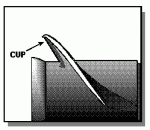Re: Newb looking for a crash course in performance for a scarab sprint
It all comes down to cubic dollars.
"How fast do you want to spend"?
Give us some idea of what kind of budget you're talking about and maybe you'll get some relevent ideas.
The only real improvement you're going to find that will help you improve low end while keeping the same top end (besides forced induction) is a variable pitch prop. A CVT would help a little, but the prop slip when you accelerate almost duplicates that now. Watch the tach when you hammer the throttle from a standstill. On most boats it will wind up to the 3000-4000 RPM range before slowly dropping down then starting to climb again as the prop hooks up. The addition of a CVT isn't worth the hassle. A CVT would gain you maybe 10-20% in low end performance. It's much cheaper and less complicated just to get a boat with a V6 in it to get better performance.
A transmission would do the same thing. The racing ski boats commonly use automotive automatic transmissions to allow them to accelerate hard but still run over 100 MPH. Again, how much do you want to spend? All the stuff you're talking about is already out there. They had a drop-in 2-speed transmissions for the Volvo's a couple of years ago:
http://news.thomasnet.com/fullstory/Marine-Transmission-has-automatic-gearbox-design-461275
There have been lots of variable pitch props on the market. You'll find that Strength and Price are generally engineering opposites. The cheap variable pitch props blew apart easily and consequently went out of business, while the ones well-engineered and well-built enough to stand up to the environment aren't cheap.
Another theory question, is it worth it at all to consider dual props (counter rotating or not)?
Not on a 3.0L. Not enough torque down low that you have to worry about hooking it up. Dual props (Mercruiser Bravo III and Volvo-Penta Duo Prop) have been around for over 20 years and are very common on bigger motors. It's been pretty well established that they improve low speed handling tremendously, help a little with acceleration (maybe 10% to 20% faster), and cost you a couple of MPH on top speed.




















